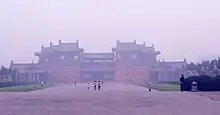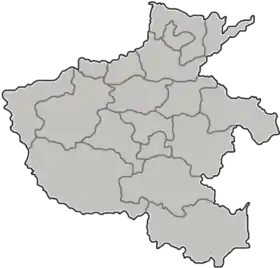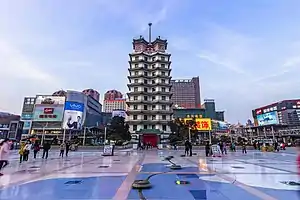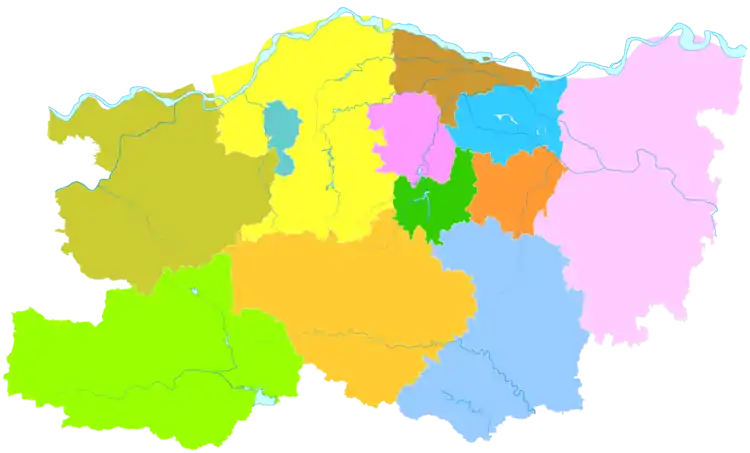Gongyi
Gongyi (simplified Chinese: 巩义市; traditional Chinese: 鞏義市; pinyin: Gǒngyì Shì), formerly Gong County (巩县; 鞏縣; Gǒngxiàn), is a county-level city of Henan Province, South Central China, it is under the administration of the prefecture-level city of Zhengzhou. It has a population of 790,000 people and an area of 1,041 km2 (402 sq mi).[3]
Gongyi
巩义市 | |
|---|---|
 Gate towers leading into the Song tombs. | |
 Gongyi Location in Henan | |
| Coordinates: 34°46′N 112°58′E | |
| Country | People's Republic of China |
| Province | Henan |
| Prefecture-level city | Zhengzhou |
| Area | |
| • Total | 1,041 km2 (402 sq mi) |
| Population (2019)[2] | |
| • Total | 843,900 |
| • Density | 810/km2 (2,100/sq mi) |
| Time zone | UTC+8 (China Standard) |
| Postal code | 451200 |
| Website | www |
Gongyi is located in the middle of Henan province, on the northern side of Mount Song. The Yellow River runs through the northern part of the city. Zhengzhou city proper lies 82 km (51 mi) to the east and Luoyang 76 km (47 mi) to the west.
The city was once known as Zhenxun (斟鄩), and was reputedly capital of China during part of the Xia dynasty. According to the Bamboo Annals, Houyi occupied Zhenxun with his forces while the Xia king Taikang was off hunting beyond the Luo River. He was then usurped by his lieutenant Han Zhuo and his son before the Xia were eventually restored.
The celebrated Song tombs are scattered through the towns (zhen) of Xicun, Zhitian, and Huiguo. They are the resting place for 7 emperors of the Northern Song dynasty and the father of the dynasty's founder. There are also the graves of loyal ministers of the Song.
After the founding of the People’s Republic of China, Gongyi was placed under the jurisdiction of Zhengzhou but came under the control of Kaifeng in January 1955 before reverting to Zhengzhou in August 1983. In 1991, Gongyi became a county-level city, still under the jurisdiction of Zhengzhou.
Gongyi is thought to be the birthplace of the Tang dynasty poet Du Fu, often considered China's greatest poet.
Administrative divisions
As 2012, this city is divided to 5 subdistricts and 15 towns.[4]
- Subdistricts
|
|
- Towns
|
|
References
- 最新人口信息 www.hongheiku.com (in Chinese). hongheiku. Retrieved 2021-01-12.
- 最新人口信息 www.hongheiku.com (in Chinese). hongheiku. Retrieved 2021-01-12.
- Geography of Gongyi Archived 2007-12-06 at the Wayback Machine, Official website of Gongyi Government, visited on April 12, 2008.
- 洛阳市-行政区划网 www.xzqh.org (in Chinese). XZQH. Retrieved 2012-05-24.

